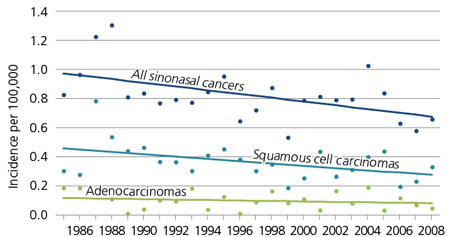Sinonasal cancer incidence per 100,000 population, by cancer type, BC, 1985-2008
In brief
- Wood dust exposure is linked to cancers of the nasopharynx, sinonasal cavities, and possibly the larynx (IARC 1995).
- We used compensation and BC Cancer Agency tumour registry data to estimate sinonasal cancer incidence rates in the BC population for 1985 to 2008.
- We found declining rates of sinonasal cancer, probably due to declining rates of squamous cell carcinomas for which smoking is a strong risk factor.
- Rates of the less common adenocarcinomas, for which occupational wood dust exposure is an established risk factor, have declined at a slower rate.
- We found cumulative incidence rates from 1985 to 2008 for adenocarcinomas were highest in the North Shore-Coast Garibaldi, Kootenay–Boundary, Fraser East, and South Island regions.
Next steps
We are now examining wood dust related cancers in relation to occupation and industry of employment. Using job-exposure matrices for wood dust allows us to assign occupations into risk groups and examine whether occupations at high risk of wood dust exposure have higher rates of sinonasal, nasopharyngeal, or laryngeal cancers.

